An Analysis of Operations Management at Mercedes-Benz: A Report
VerifiedAdded on 2023/01/09
|11
|3805
|25
Report
AI Summary
This report provides a detailed analysis of operations management within Mercedes-Benz, a leading luxury automotive manufacturer. It examines the application of quality management principles, particularly Total Quality Management (TQM), highlighting how Mercedes-Benz uses automated processes, real-time scanning, and external collaborations to ensure high-quality products and customer satisfaction. The report further explores the significance of plant location and layout in optimizing production efficiency, detailing Mercedes-Benz's strategic investments in global plants and its innovative 'Factory 56' concept, which emphasizes smart production, flexible layouts, and sustainable practices. The analysis covers aspects such as supply chain management, employee motivation, and the company's efforts to adapt to market trends and customer demands. Overall, the report underscores the importance of operations management in Mercedes-Benz's success, emphasizing quality, strategic plant location, and technological advancements.
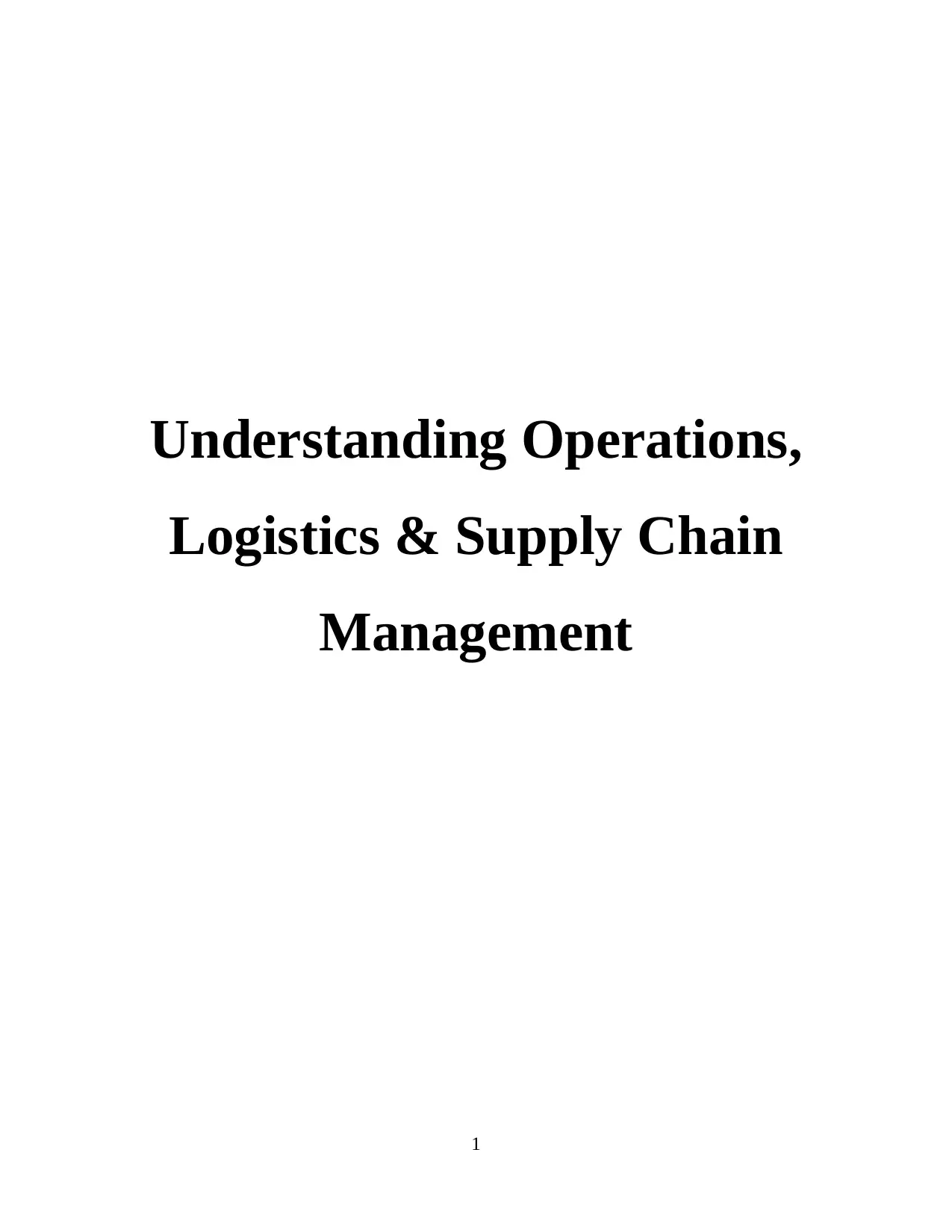
Understanding Operations,
Logistics & Supply Chain
Management
1
Logistics & Supply Chain
Management
1
Paraphrase This Document
Need a fresh take? Get an instant paraphrase of this document with our AI Paraphraser
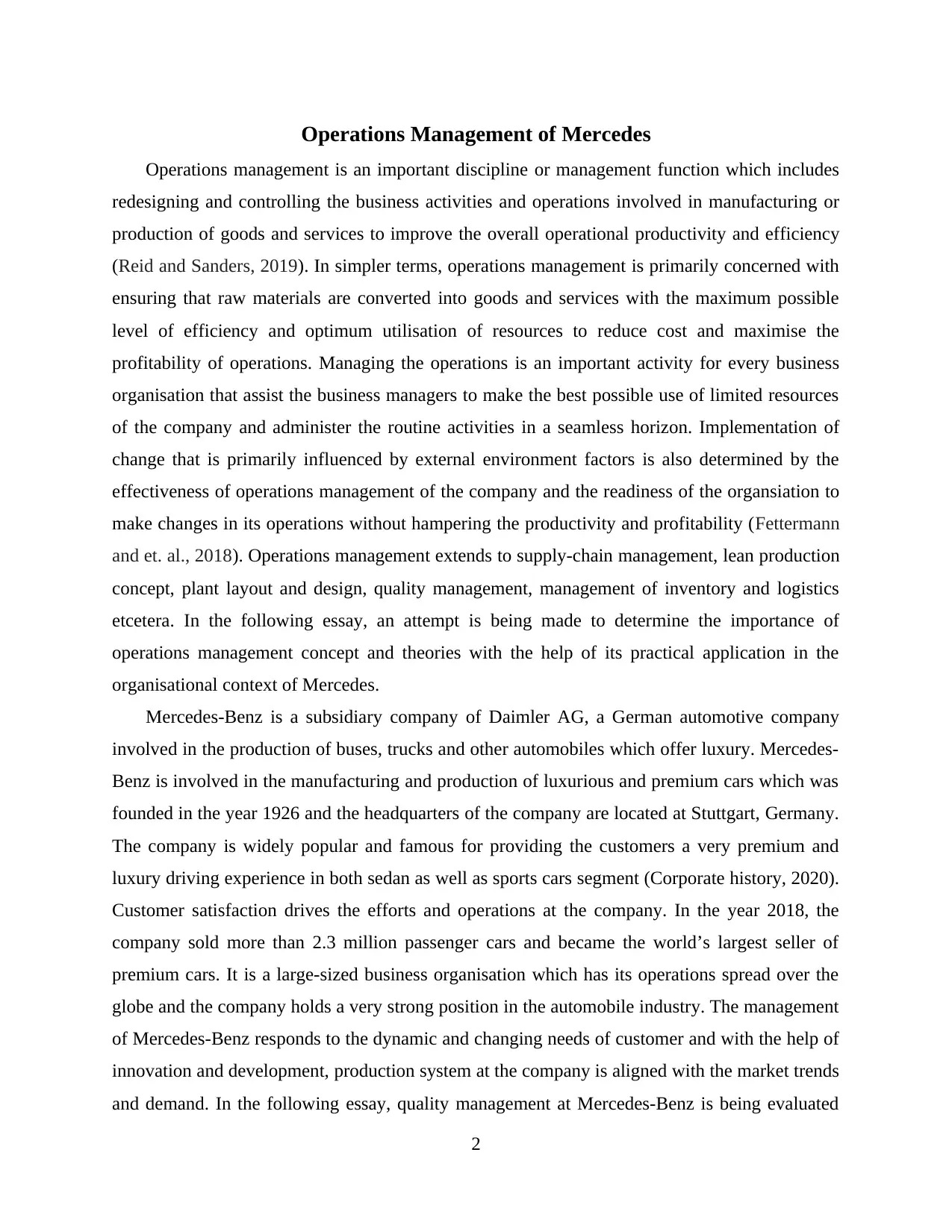
Operations Management of Mercedes
Operations management is an important discipline or management function which includes
redesigning and controlling the business activities and operations involved in manufacturing or
production of goods and services to improve the overall operational productivity and efficiency
(Reid and Sanders, 2019). In simpler terms, operations management is primarily concerned with
ensuring that raw materials are converted into goods and services with the maximum possible
level of efficiency and optimum utilisation of resources to reduce cost and maximise the
profitability of operations. Managing the operations is an important activity for every business
organisation that assist the business managers to make the best possible use of limited resources
of the company and administer the routine activities in a seamless horizon. Implementation of
change that is primarily influenced by external environment factors is also determined by the
effectiveness of operations management of the company and the readiness of the organsiation to
make changes in its operations without hampering the productivity and profitability (Fettermann
and et. al., 2018). Operations management extends to supply-chain management, lean production
concept, plant layout and design, quality management, management of inventory and logistics
etcetera. In the following essay, an attempt is being made to determine the importance of
operations management concept and theories with the help of its practical application in the
organisational context of Mercedes.
Mercedes-Benz is a subsidiary company of Daimler AG, a German automotive company
involved in the production of buses, trucks and other automobiles which offer luxury. Mercedes-
Benz is involved in the manufacturing and production of luxurious and premium cars which was
founded in the year 1926 and the headquarters of the company are located at Stuttgart, Germany.
The company is widely popular and famous for providing the customers a very premium and
luxury driving experience in both sedan as well as sports cars segment (Corporate history, 2020).
Customer satisfaction drives the efforts and operations at the company. In the year 2018, the
company sold more than 2.3 million passenger cars and became the world’s largest seller of
premium cars. It is a large-sized business organisation which has its operations spread over the
globe and the company holds a very strong position in the automobile industry. The management
of Mercedes-Benz responds to the dynamic and changing needs of customer and with the help of
innovation and development, production system at the company is aligned with the market trends
and demand. In the following essay, quality management at Mercedes-Benz is being evaluated
2
Operations management is an important discipline or management function which includes
redesigning and controlling the business activities and operations involved in manufacturing or
production of goods and services to improve the overall operational productivity and efficiency
(Reid and Sanders, 2019). In simpler terms, operations management is primarily concerned with
ensuring that raw materials are converted into goods and services with the maximum possible
level of efficiency and optimum utilisation of resources to reduce cost and maximise the
profitability of operations. Managing the operations is an important activity for every business
organisation that assist the business managers to make the best possible use of limited resources
of the company and administer the routine activities in a seamless horizon. Implementation of
change that is primarily influenced by external environment factors is also determined by the
effectiveness of operations management of the company and the readiness of the organsiation to
make changes in its operations without hampering the productivity and profitability (Fettermann
and et. al., 2018). Operations management extends to supply-chain management, lean production
concept, plant layout and design, quality management, management of inventory and logistics
etcetera. In the following essay, an attempt is being made to determine the importance of
operations management concept and theories with the help of its practical application in the
organisational context of Mercedes.
Mercedes-Benz is a subsidiary company of Daimler AG, a German automotive company
involved in the production of buses, trucks and other automobiles which offer luxury. Mercedes-
Benz is involved in the manufacturing and production of luxurious and premium cars which was
founded in the year 1926 and the headquarters of the company are located at Stuttgart, Germany.
The company is widely popular and famous for providing the customers a very premium and
luxury driving experience in both sedan as well as sports cars segment (Corporate history, 2020).
Customer satisfaction drives the efforts and operations at the company. In the year 2018, the
company sold more than 2.3 million passenger cars and became the world’s largest seller of
premium cars. It is a large-sized business organisation which has its operations spread over the
globe and the company holds a very strong position in the automobile industry. The management
of Mercedes-Benz responds to the dynamic and changing needs of customer and with the help of
innovation and development, production system at the company is aligned with the market trends
and demand. In the following essay, quality management at Mercedes-Benz is being evaluated
2
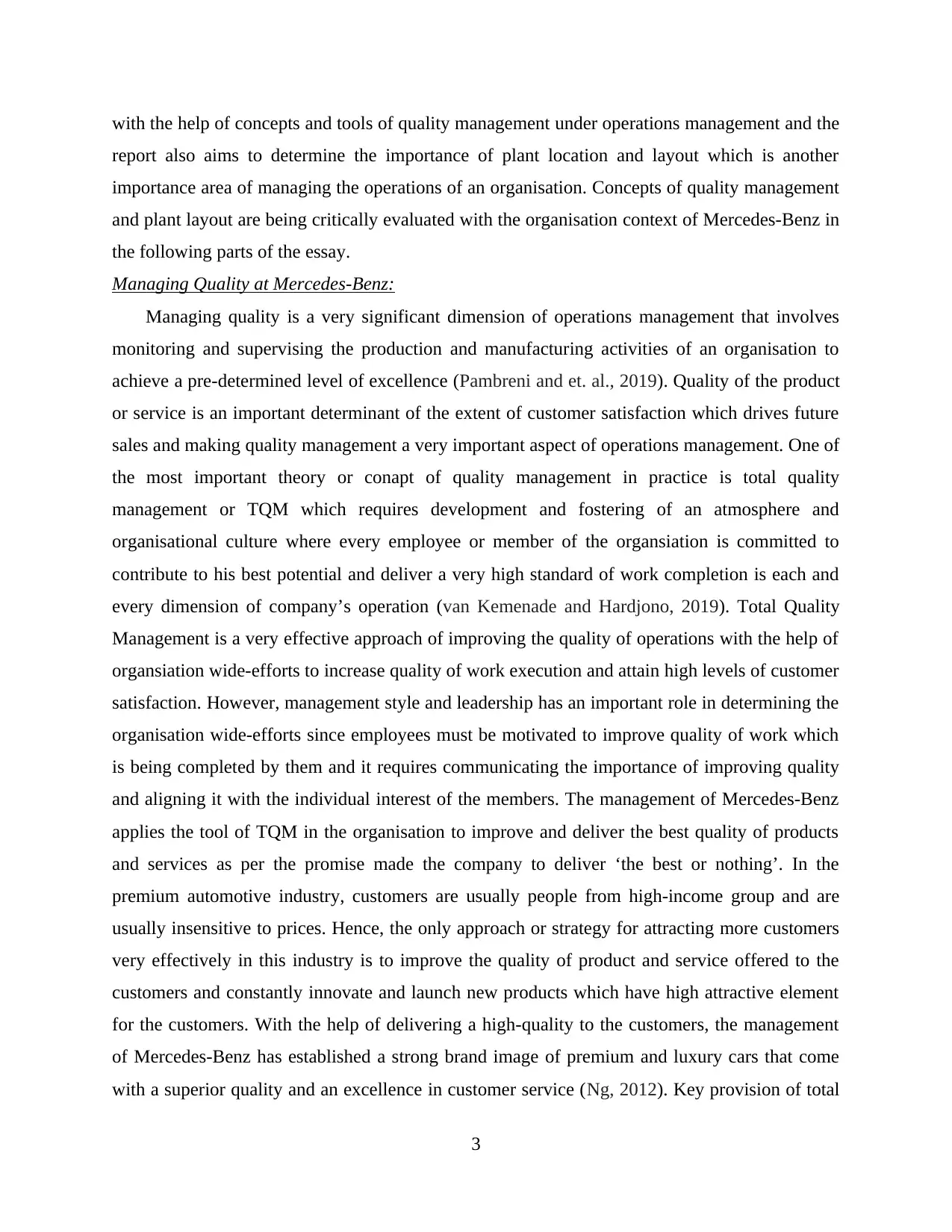
with the help of concepts and tools of quality management under operations management and the
report also aims to determine the importance of plant location and layout which is another
importance area of managing the operations of an organisation. Concepts of quality management
and plant layout are being critically evaluated with the organisation context of Mercedes-Benz in
the following parts of the essay.
Managing Quality at Mercedes-Benz:
Managing quality is a very significant dimension of operations management that involves
monitoring and supervising the production and manufacturing activities of an organisation to
achieve a pre-determined level of excellence (Pambreni and et. al., 2019). Quality of the product
or service is an important determinant of the extent of customer satisfaction which drives future
sales and making quality management a very important aspect of operations management. One of
the most important theory or conapt of quality management in practice is total quality
management or TQM which requires development and fostering of an atmosphere and
organisational culture where every employee or member of the organsiation is committed to
contribute to his best potential and deliver a very high standard of work completion is each and
every dimension of company’s operation (van Kemenade and Hardjono, 2019). Total Quality
Management is a very effective approach of improving the quality of operations with the help of
organsiation wide-efforts to increase quality of work execution and attain high levels of customer
satisfaction. However, management style and leadership has an important role in determining the
organisation wide-efforts since employees must be motivated to improve quality of work which
is being completed by them and it requires communicating the importance of improving quality
and aligning it with the individual interest of the members. The management of Mercedes-Benz
applies the tool of TQM in the organisation to improve and deliver the best quality of products
and services as per the promise made the company to deliver ‘the best or nothing’. In the
premium automotive industry, customers are usually people from high-income group and are
usually insensitive to prices. Hence, the only approach or strategy for attracting more customers
very effectively in this industry is to improve the quality of product and service offered to the
customers and constantly innovate and launch new products which have high attractive element
for the customers. With the help of delivering a high-quality to the customers, the management
of Mercedes-Benz has established a strong brand image of premium and luxury cars that come
with a superior quality and an excellence in customer service (Ng, 2012). Key provision of total
3
report also aims to determine the importance of plant location and layout which is another
importance area of managing the operations of an organisation. Concepts of quality management
and plant layout are being critically evaluated with the organisation context of Mercedes-Benz in
the following parts of the essay.
Managing Quality at Mercedes-Benz:
Managing quality is a very significant dimension of operations management that involves
monitoring and supervising the production and manufacturing activities of an organisation to
achieve a pre-determined level of excellence (Pambreni and et. al., 2019). Quality of the product
or service is an important determinant of the extent of customer satisfaction which drives future
sales and making quality management a very important aspect of operations management. One of
the most important theory or conapt of quality management in practice is total quality
management or TQM which requires development and fostering of an atmosphere and
organisational culture where every employee or member of the organsiation is committed to
contribute to his best potential and deliver a very high standard of work completion is each and
every dimension of company’s operation (van Kemenade and Hardjono, 2019). Total Quality
Management is a very effective approach of improving the quality of operations with the help of
organsiation wide-efforts to increase quality of work execution and attain high levels of customer
satisfaction. However, management style and leadership has an important role in determining the
organisation wide-efforts since employees must be motivated to improve quality of work which
is being completed by them and it requires communicating the importance of improving quality
and aligning it with the individual interest of the members. The management of Mercedes-Benz
applies the tool of TQM in the organisation to improve and deliver the best quality of products
and services as per the promise made the company to deliver ‘the best or nothing’. In the
premium automotive industry, customers are usually people from high-income group and are
usually insensitive to prices. Hence, the only approach or strategy for attracting more customers
very effectively in this industry is to improve the quality of product and service offered to the
customers and constantly innovate and launch new products which have high attractive element
for the customers. With the help of delivering a high-quality to the customers, the management
of Mercedes-Benz has established a strong brand image of premium and luxury cars that come
with a superior quality and an excellence in customer service (Ng, 2012). Key provision of total
3
⊘ This is a preview!⊘
Do you want full access?
Subscribe today to unlock all pages.

Trusted by 1+ million students worldwide
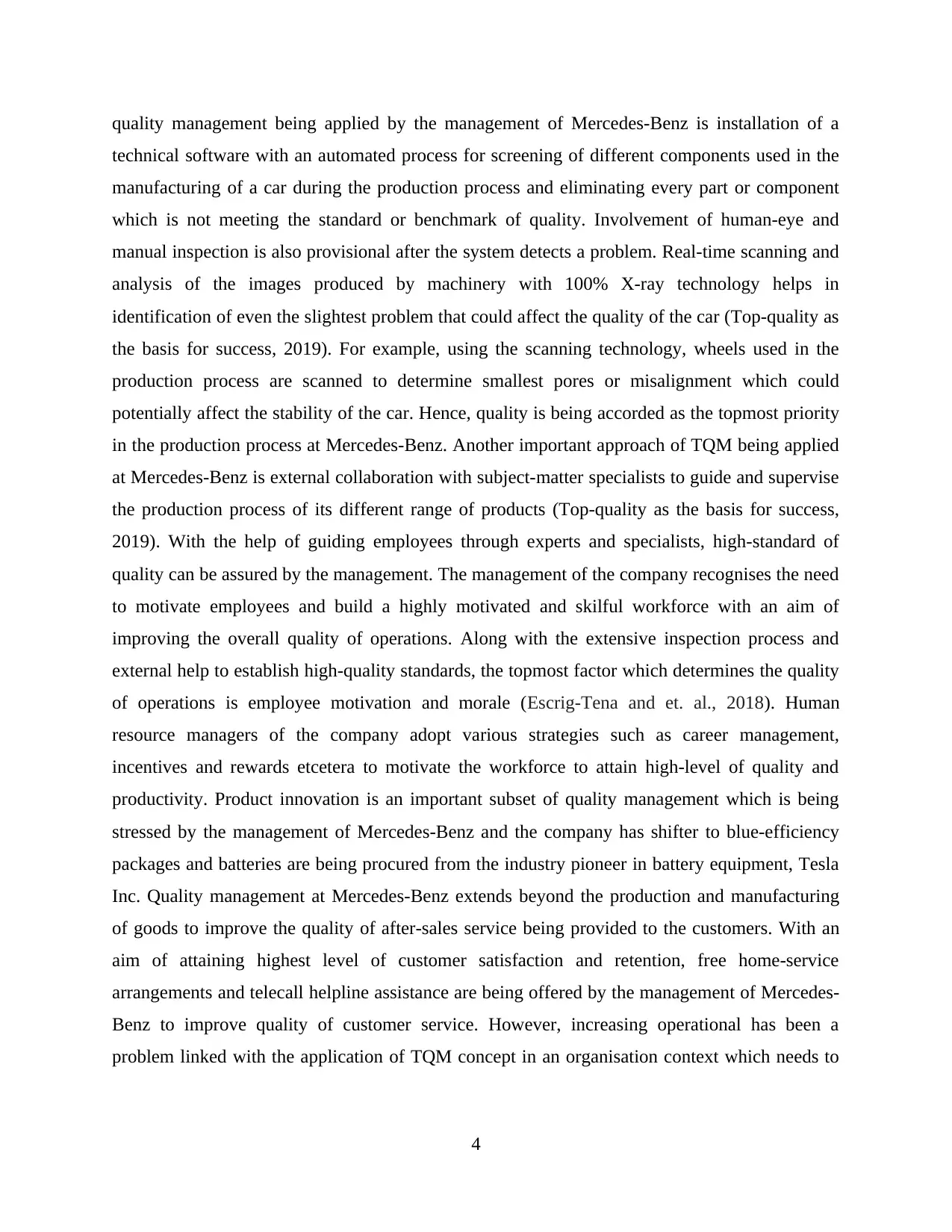
quality management being applied by the management of Mercedes-Benz is installation of a
technical software with an automated process for screening of different components used in the
manufacturing of a car during the production process and eliminating every part or component
which is not meeting the standard or benchmark of quality. Involvement of human-eye and
manual inspection is also provisional after the system detects a problem. Real-time scanning and
analysis of the images produced by machinery with 100% X-ray technology helps in
identification of even the slightest problem that could affect the quality of the car (Top-quality as
the basis for success, 2019). For example, using the scanning technology, wheels used in the
production process are scanned to determine smallest pores or misalignment which could
potentially affect the stability of the car. Hence, quality is being accorded as the topmost priority
in the production process at Mercedes-Benz. Another important approach of TQM being applied
at Mercedes-Benz is external collaboration with subject-matter specialists to guide and supervise
the production process of its different range of products (Top-quality as the basis for success,
2019). With the help of guiding employees through experts and specialists, high-standard of
quality can be assured by the management. The management of the company recognises the need
to motivate employees and build a highly motivated and skilful workforce with an aim of
improving the overall quality of operations. Along with the extensive inspection process and
external help to establish high-quality standards, the topmost factor which determines the quality
of operations is employee motivation and morale (Escrig-Tena and et. al., 2018). Human
resource managers of the company adopt various strategies such as career management,
incentives and rewards etcetera to motivate the workforce to attain high-level of quality and
productivity. Product innovation is an important subset of quality management which is being
stressed by the management of Mercedes-Benz and the company has shifter to blue-efficiency
packages and batteries are being procured from the industry pioneer in battery equipment, Tesla
Inc. Quality management at Mercedes-Benz extends beyond the production and manufacturing
of goods to improve the quality of after-sales service being provided to the customers. With an
aim of attaining highest level of customer satisfaction and retention, free home-service
arrangements and telecall helpline assistance are being offered by the management of Mercedes-
Benz to improve quality of customer service. However, increasing operational has been a
problem linked with the application of TQM concept in an organisation context which needs to
4
technical software with an automated process for screening of different components used in the
manufacturing of a car during the production process and eliminating every part or component
which is not meeting the standard or benchmark of quality. Involvement of human-eye and
manual inspection is also provisional after the system detects a problem. Real-time scanning and
analysis of the images produced by machinery with 100% X-ray technology helps in
identification of even the slightest problem that could affect the quality of the car (Top-quality as
the basis for success, 2019). For example, using the scanning technology, wheels used in the
production process are scanned to determine smallest pores or misalignment which could
potentially affect the stability of the car. Hence, quality is being accorded as the topmost priority
in the production process at Mercedes-Benz. Another important approach of TQM being applied
at Mercedes-Benz is external collaboration with subject-matter specialists to guide and supervise
the production process of its different range of products (Top-quality as the basis for success,
2019). With the help of guiding employees through experts and specialists, high-standard of
quality can be assured by the management. The management of the company recognises the need
to motivate employees and build a highly motivated and skilful workforce with an aim of
improving the overall quality of operations. Along with the extensive inspection process and
external help to establish high-quality standards, the topmost factor which determines the quality
of operations is employee motivation and morale (Escrig-Tena and et. al., 2018). Human
resource managers of the company adopt various strategies such as career management,
incentives and rewards etcetera to motivate the workforce to attain high-level of quality and
productivity. Product innovation is an important subset of quality management which is being
stressed by the management of Mercedes-Benz and the company has shifter to blue-efficiency
packages and batteries are being procured from the industry pioneer in battery equipment, Tesla
Inc. Quality management at Mercedes-Benz extends beyond the production and manufacturing
of goods to improve the quality of after-sales service being provided to the customers. With an
aim of attaining highest level of customer satisfaction and retention, free home-service
arrangements and telecall helpline assistance are being offered by the management of Mercedes-
Benz to improve quality of customer service. However, increasing operational has been a
problem linked with the application of TQM concept in an organisation context which needs to
4
Paraphrase This Document
Need a fresh take? Get an instant paraphrase of this document with our AI Paraphraser
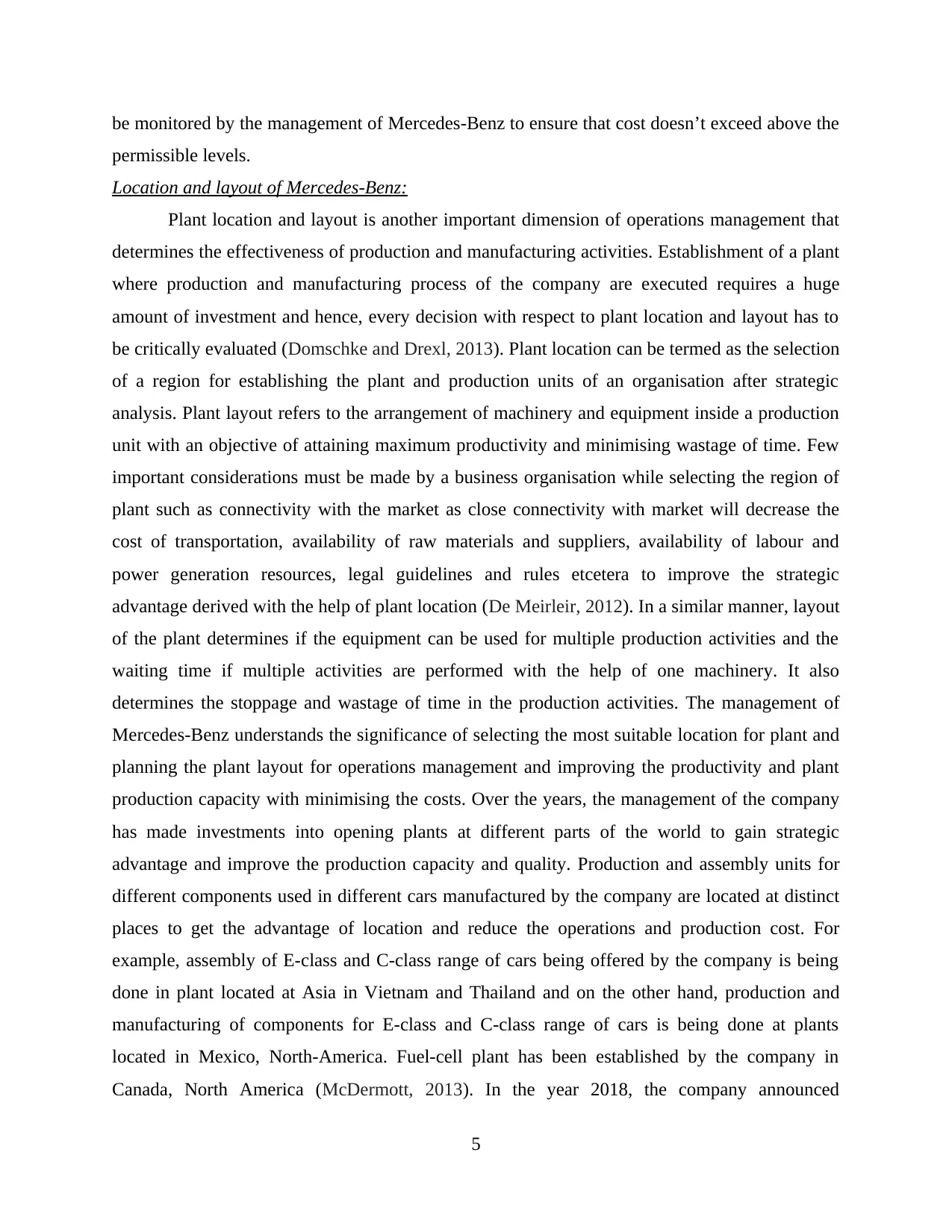
be monitored by the management of Mercedes-Benz to ensure that cost doesn’t exceed above the
permissible levels.
Location and layout of Mercedes-Benz:
Plant location and layout is another important dimension of operations management that
determines the effectiveness of production and manufacturing activities. Establishment of a plant
where production and manufacturing process of the company are executed requires a huge
amount of investment and hence, every decision with respect to plant location and layout has to
be critically evaluated (Domschke and Drexl, 2013). Plant location can be termed as the selection
of a region for establishing the plant and production units of an organisation after strategic
analysis. Plant layout refers to the arrangement of machinery and equipment inside a production
unit with an objective of attaining maximum productivity and minimising wastage of time. Few
important considerations must be made by a business organisation while selecting the region of
plant such as connectivity with the market as close connectivity with market will decrease the
cost of transportation, availability of raw materials and suppliers, availability of labour and
power generation resources, legal guidelines and rules etcetera to improve the strategic
advantage derived with the help of plant location (De Meirleir, 2012). In a similar manner, layout
of the plant determines if the equipment can be used for multiple production activities and the
waiting time if multiple activities are performed with the help of one machinery. It also
determines the stoppage and wastage of time in the production activities. The management of
Mercedes-Benz understands the significance of selecting the most suitable location for plant and
planning the plant layout for operations management and improving the productivity and plant
production capacity with minimising the costs. Over the years, the management of the company
has made investments into opening plants at different parts of the world to gain strategic
advantage and improve the production capacity and quality. Production and assembly units for
different components used in different cars manufactured by the company are located at distinct
places to get the advantage of location and reduce the operations and production cost. For
example, assembly of E-class and C-class range of cars being offered by the company is being
done in plant located at Asia in Vietnam and Thailand and on the other hand, production and
manufacturing of components for E-class and C-class range of cars is being done at plants
located in Mexico, North-America. Fuel-cell plant has been established by the company in
Canada, North America (McDermott, 2013). In the year 2018, the company announced
5
permissible levels.
Location and layout of Mercedes-Benz:
Plant location and layout is another important dimension of operations management that
determines the effectiveness of production and manufacturing activities. Establishment of a plant
where production and manufacturing process of the company are executed requires a huge
amount of investment and hence, every decision with respect to plant location and layout has to
be critically evaluated (Domschke and Drexl, 2013). Plant location can be termed as the selection
of a region for establishing the plant and production units of an organisation after strategic
analysis. Plant layout refers to the arrangement of machinery and equipment inside a production
unit with an objective of attaining maximum productivity and minimising wastage of time. Few
important considerations must be made by a business organisation while selecting the region of
plant such as connectivity with the market as close connectivity with market will decrease the
cost of transportation, availability of raw materials and suppliers, availability of labour and
power generation resources, legal guidelines and rules etcetera to improve the strategic
advantage derived with the help of plant location (De Meirleir, 2012). In a similar manner, layout
of the plant determines if the equipment can be used for multiple production activities and the
waiting time if multiple activities are performed with the help of one machinery. It also
determines the stoppage and wastage of time in the production activities. The management of
Mercedes-Benz understands the significance of selecting the most suitable location for plant and
planning the plant layout for operations management and improving the productivity and plant
production capacity with minimising the costs. Over the years, the management of the company
has made investments into opening plants at different parts of the world to gain strategic
advantage and improve the production capacity and quality. Production and assembly units for
different components used in different cars manufactured by the company are located at distinct
places to get the advantage of location and reduce the operations and production cost. For
example, assembly of E-class and C-class range of cars being offered by the company is being
done in plant located at Asia in Vietnam and Thailand and on the other hand, production and
manufacturing of components for E-class and C-class range of cars is being done at plants
located in Mexico, North-America. Fuel-cell plant has been established by the company in
Canada, North America (McDermott, 2013). In the year 2018, the company announced
5
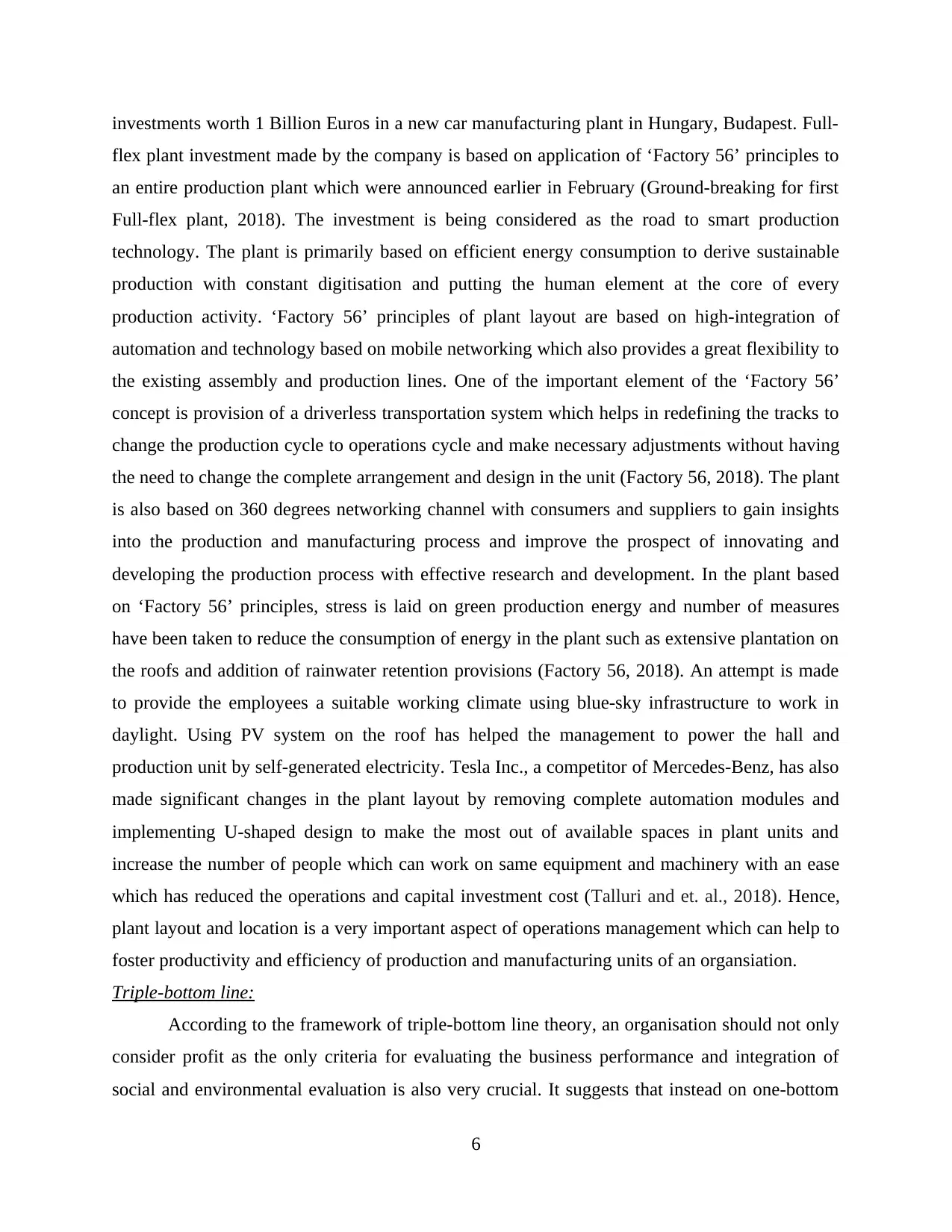
investments worth 1 Billion Euros in a new car manufacturing plant in Hungary, Budapest. Full-
flex plant investment made by the company is based on application of ‘Factory 56’ principles to
an entire production plant which were announced earlier in February (Ground-breaking for first
Full-flex plant, 2018). The investment is being considered as the road to smart production
technology. The plant is primarily based on efficient energy consumption to derive sustainable
production with constant digitisation and putting the human element at the core of every
production activity. ‘Factory 56’ principles of plant layout are based on high-integration of
automation and technology based on mobile networking which also provides a great flexibility to
the existing assembly and production lines. One of the important element of the ‘Factory 56’
concept is provision of a driverless transportation system which helps in redefining the tracks to
change the production cycle to operations cycle and make necessary adjustments without having
the need to change the complete arrangement and design in the unit (Factory 56, 2018). The plant
is also based on 360 degrees networking channel with consumers and suppliers to gain insights
into the production and manufacturing process and improve the prospect of innovating and
developing the production process with effective research and development. In the plant based
on ‘Factory 56’ principles, stress is laid on green production energy and number of measures
have been taken to reduce the consumption of energy in the plant such as extensive plantation on
the roofs and addition of rainwater retention provisions (Factory 56, 2018). An attempt is made
to provide the employees a suitable working climate using blue-sky infrastructure to work in
daylight. Using PV system on the roof has helped the management to power the hall and
production unit by self-generated electricity. Tesla Inc., a competitor of Mercedes-Benz, has also
made significant changes in the plant layout by removing complete automation modules and
implementing U-shaped design to make the most out of available spaces in plant units and
increase the number of people which can work on same equipment and machinery with an ease
which has reduced the operations and capital investment cost (Talluri and et. al., 2018). Hence,
plant layout and location is a very important aspect of operations management which can help to
foster productivity and efficiency of production and manufacturing units of an organsiation.
Triple-bottom line:
According to the framework of triple-bottom line theory, an organisation should not only
consider profit as the only criteria for evaluating the business performance and integration of
social and environmental evaluation is also very crucial. It suggests that instead on one-bottom
6
flex plant investment made by the company is based on application of ‘Factory 56’ principles to
an entire production plant which were announced earlier in February (Ground-breaking for first
Full-flex plant, 2018). The investment is being considered as the road to smart production
technology. The plant is primarily based on efficient energy consumption to derive sustainable
production with constant digitisation and putting the human element at the core of every
production activity. ‘Factory 56’ principles of plant layout are based on high-integration of
automation and technology based on mobile networking which also provides a great flexibility to
the existing assembly and production lines. One of the important element of the ‘Factory 56’
concept is provision of a driverless transportation system which helps in redefining the tracks to
change the production cycle to operations cycle and make necessary adjustments without having
the need to change the complete arrangement and design in the unit (Factory 56, 2018). The plant
is also based on 360 degrees networking channel with consumers and suppliers to gain insights
into the production and manufacturing process and improve the prospect of innovating and
developing the production process with effective research and development. In the plant based
on ‘Factory 56’ principles, stress is laid on green production energy and number of measures
have been taken to reduce the consumption of energy in the plant such as extensive plantation on
the roofs and addition of rainwater retention provisions (Factory 56, 2018). An attempt is made
to provide the employees a suitable working climate using blue-sky infrastructure to work in
daylight. Using PV system on the roof has helped the management to power the hall and
production unit by self-generated electricity. Tesla Inc., a competitor of Mercedes-Benz, has also
made significant changes in the plant layout by removing complete automation modules and
implementing U-shaped design to make the most out of available spaces in plant units and
increase the number of people which can work on same equipment and machinery with an ease
which has reduced the operations and capital investment cost (Talluri and et. al., 2018). Hence,
plant layout and location is a very important aspect of operations management which can help to
foster productivity and efficiency of production and manufacturing units of an organsiation.
Triple-bottom line:
According to the framework of triple-bottom line theory, an organisation should not only
consider profit as the only criteria for evaluating the business performance and integration of
social and environmental evaluation is also very crucial. It suggests that instead on one-bottom
6
⊘ This is a preview!⊘
Do you want full access?
Subscribe today to unlock all pages.

Trusted by 1+ million students worldwide
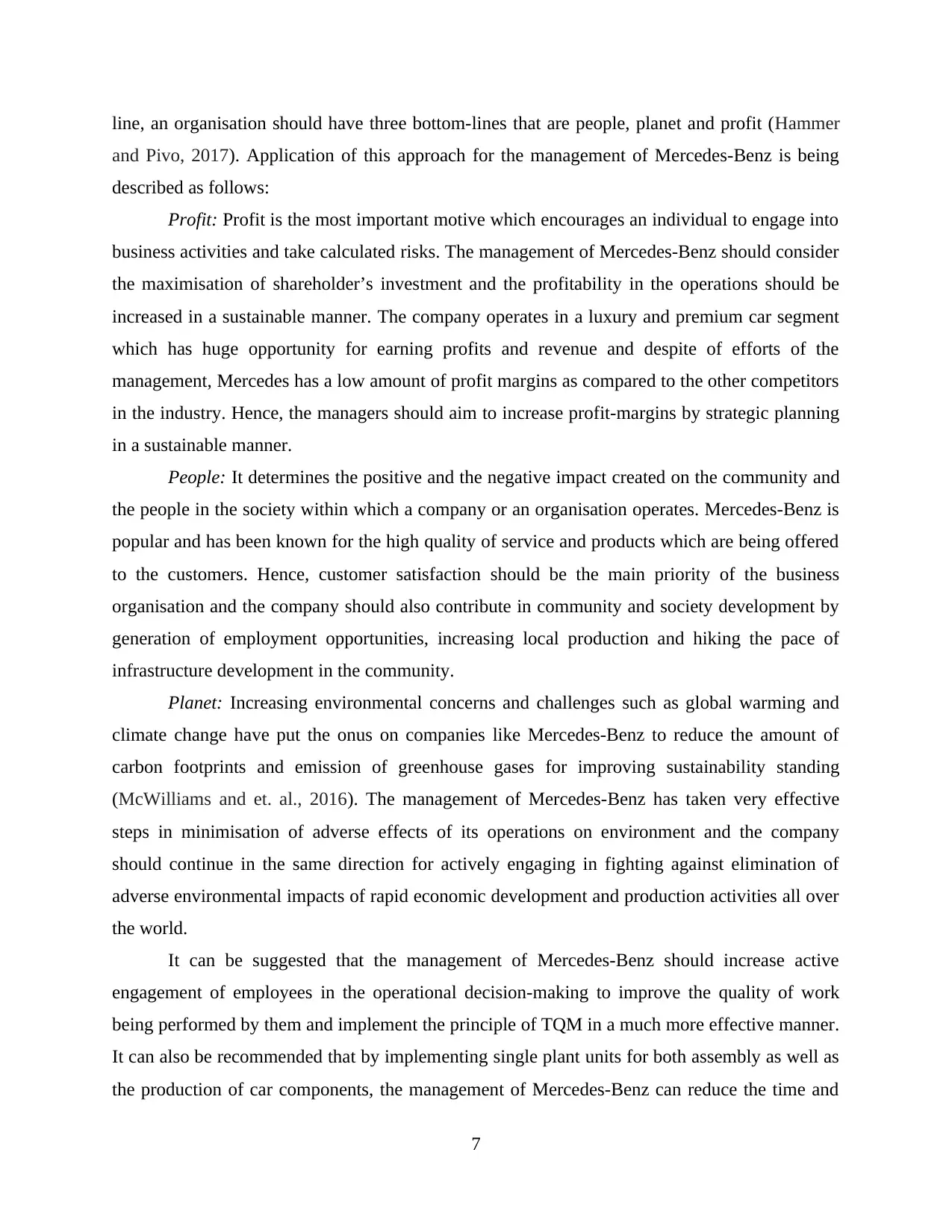
line, an organisation should have three bottom-lines that are people, planet and profit (Hammer
and Pivo, 2017). Application of this approach for the management of Mercedes-Benz is being
described as follows:
Profit: Profit is the most important motive which encourages an individual to engage into
business activities and take calculated risks. The management of Mercedes-Benz should consider
the maximisation of shareholder’s investment and the profitability in the operations should be
increased in a sustainable manner. The company operates in a luxury and premium car segment
which has huge opportunity for earning profits and revenue and despite of efforts of the
management, Mercedes has a low amount of profit margins as compared to the other competitors
in the industry. Hence, the managers should aim to increase profit-margins by strategic planning
in a sustainable manner.
People: It determines the positive and the negative impact created on the community and
the people in the society within which a company or an organisation operates. Mercedes-Benz is
popular and has been known for the high quality of service and products which are being offered
to the customers. Hence, customer satisfaction should be the main priority of the business
organisation and the company should also contribute in community and society development by
generation of employment opportunities, increasing local production and hiking the pace of
infrastructure development in the community.
Planet: Increasing environmental concerns and challenges such as global warming and
climate change have put the onus on companies like Mercedes-Benz to reduce the amount of
carbon footprints and emission of greenhouse gases for improving sustainability standing
(McWilliams and et. al., 2016). The management of Mercedes-Benz has taken very effective
steps in minimisation of adverse effects of its operations on environment and the company
should continue in the same direction for actively engaging in fighting against elimination of
adverse environmental impacts of rapid economic development and production activities all over
the world.
It can be suggested that the management of Mercedes-Benz should increase active
engagement of employees in the operational decision-making to improve the quality of work
being performed by them and implement the principle of TQM in a much more effective manner.
It can also be recommended that by implementing single plant units for both assembly as well as
the production of car components, the management of Mercedes-Benz can reduce the time and
7
and Pivo, 2017). Application of this approach for the management of Mercedes-Benz is being
described as follows:
Profit: Profit is the most important motive which encourages an individual to engage into
business activities and take calculated risks. The management of Mercedes-Benz should consider
the maximisation of shareholder’s investment and the profitability in the operations should be
increased in a sustainable manner. The company operates in a luxury and premium car segment
which has huge opportunity for earning profits and revenue and despite of efforts of the
management, Mercedes has a low amount of profit margins as compared to the other competitors
in the industry. Hence, the managers should aim to increase profit-margins by strategic planning
in a sustainable manner.
People: It determines the positive and the negative impact created on the community and
the people in the society within which a company or an organisation operates. Mercedes-Benz is
popular and has been known for the high quality of service and products which are being offered
to the customers. Hence, customer satisfaction should be the main priority of the business
organisation and the company should also contribute in community and society development by
generation of employment opportunities, increasing local production and hiking the pace of
infrastructure development in the community.
Planet: Increasing environmental concerns and challenges such as global warming and
climate change have put the onus on companies like Mercedes-Benz to reduce the amount of
carbon footprints and emission of greenhouse gases for improving sustainability standing
(McWilliams and et. al., 2016). The management of Mercedes-Benz has taken very effective
steps in minimisation of adverse effects of its operations on environment and the company
should continue in the same direction for actively engaging in fighting against elimination of
adverse environmental impacts of rapid economic development and production activities all over
the world.
It can be suggested that the management of Mercedes-Benz should increase active
engagement of employees in the operational decision-making to improve the quality of work
being performed by them and implement the principle of TQM in a much more effective manner.
It can also be recommended that by implementing single plant units for both assembly as well as
the production of car components, the management of Mercedes-Benz can reduce the time and
7
Paraphrase This Document
Need a fresh take? Get an instant paraphrase of this document with our AI Paraphraser

cost involved in transpiration and the effectiveness of operations management can be increased
in the organsiation. U-shaped plant layout can be implemented by the management to reduce the
amount invested in various machinery of similar nature and specification and the collaborative
use of equipment can be made more accessible in the plant units.
It can be concluded from the above essay that operations management is a very important
concept of managerial function which has different dimensions such as quality management,
plant location and layout, lean production or inventory management. It can also be concluded
that effective operations management with the help of quality management and plant location has
helped the managers of Mercedes-Benz to increase the effectiveness of the company’s operations
and improve the competitiveness in the industry.
Reflective Summary
During the course of this project work which consisted of reviewing and resubmitting my
work which I had submitted initially, I was able to determine the shortcomings of my project and
initial work as highlighted by the feedback provided by the teacher. Although, I was able to
submit my project work on time and I thought I was able to attempt all the learning outcomes
and the task requirements, analysis of the feedback provided by the tutor helped me to
understand how to critically evaluate a concept or a theory and understand its application in an
organisational context. I was not able to use proper source of information and I think my
referencing was not adequate to form a rationale conclusion or derive any outcomes. Initially, I
was not able to apply the theory and models of operation management in an organisational
context and my evaluation lacked rational thinking and logical approach to form a conclusion. I
didn’t critique the positive and negative aspects of applying different theory of operations
management in the context of Mercedes-Benz. In this review work based on the feedback of
teacher, I have followed an approach which involved understanding the concept that I am going
to apply, determine its importance and shortcomings and based on this, evaluate how effectively
the organisation has applied these concepts to derive positive outcomes and eliminate the
negative aspects. I believe this resit and review of work has helped me to develop critical-
thinking skills and I have learnt how to practically apply different concepts and approaches to
evaluate the outcomes. I also learned how to use online sources of information and use relevant
information for conducting research out of the pool of information available on the internet. I
have also gained the knowledge about different concepts of operations management and this
8
in the organsiation. U-shaped plant layout can be implemented by the management to reduce the
amount invested in various machinery of similar nature and specification and the collaborative
use of equipment can be made more accessible in the plant units.
It can be concluded from the above essay that operations management is a very important
concept of managerial function which has different dimensions such as quality management,
plant location and layout, lean production or inventory management. It can also be concluded
that effective operations management with the help of quality management and plant location has
helped the managers of Mercedes-Benz to increase the effectiveness of the company’s operations
and improve the competitiveness in the industry.
Reflective Summary
During the course of this project work which consisted of reviewing and resubmitting my
work which I had submitted initially, I was able to determine the shortcomings of my project and
initial work as highlighted by the feedback provided by the teacher. Although, I was able to
submit my project work on time and I thought I was able to attempt all the learning outcomes
and the task requirements, analysis of the feedback provided by the tutor helped me to
understand how to critically evaluate a concept or a theory and understand its application in an
organisational context. I was not able to use proper source of information and I think my
referencing was not adequate to form a rationale conclusion or derive any outcomes. Initially, I
was not able to apply the theory and models of operation management in an organisational
context and my evaluation lacked rational thinking and logical approach to form a conclusion. I
didn’t critique the positive and negative aspects of applying different theory of operations
management in the context of Mercedes-Benz. In this review work based on the feedback of
teacher, I have followed an approach which involved understanding the concept that I am going
to apply, determine its importance and shortcomings and based on this, evaluate how effectively
the organisation has applied these concepts to derive positive outcomes and eliminate the
negative aspects. I believe this resit and review of work has helped me to develop critical-
thinking skills and I have learnt how to practically apply different concepts and approaches to
evaluate the outcomes. I also learned how to use online sources of information and use relevant
information for conducting research out of the pool of information available on the internet. I
have also gained the knowledge about different concepts of operations management and this
8
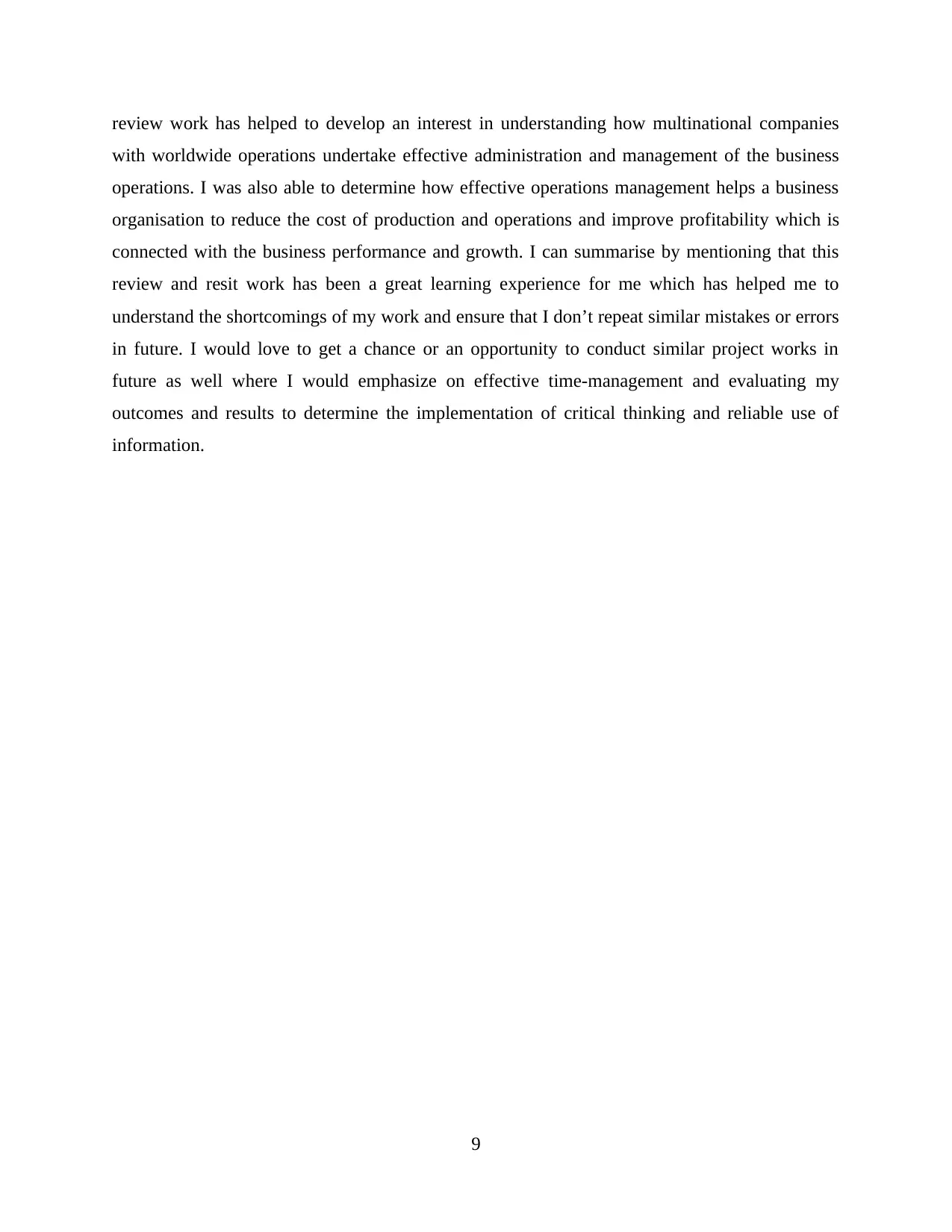
review work has helped to develop an interest in understanding how multinational companies
with worldwide operations undertake effective administration and management of the business
operations. I was also able to determine how effective operations management helps a business
organisation to reduce the cost of production and operations and improve profitability which is
connected with the business performance and growth. I can summarise by mentioning that this
review and resit work has been a great learning experience for me which has helped me to
understand the shortcomings of my work and ensure that I don’t repeat similar mistakes or errors
in future. I would love to get a chance or an opportunity to conduct similar project works in
future as well where I would emphasize on effective time-management and evaluating my
outcomes and results to determine the implementation of critical thinking and reliable use of
information.
9
with worldwide operations undertake effective administration and management of the business
operations. I was also able to determine how effective operations management helps a business
organisation to reduce the cost of production and operations and improve profitability which is
connected with the business performance and growth. I can summarise by mentioning that this
review and resit work has been a great learning experience for me which has helped me to
understand the shortcomings of my work and ensure that I don’t repeat similar mistakes or errors
in future. I would love to get a chance or an opportunity to conduct similar project works in
future as well where I would emphasize on effective time-management and evaluating my
outcomes and results to determine the implementation of critical thinking and reliable use of
information.
9
⊘ This is a preview!⊘
Do you want full access?
Subscribe today to unlock all pages.

Trusted by 1+ million students worldwide
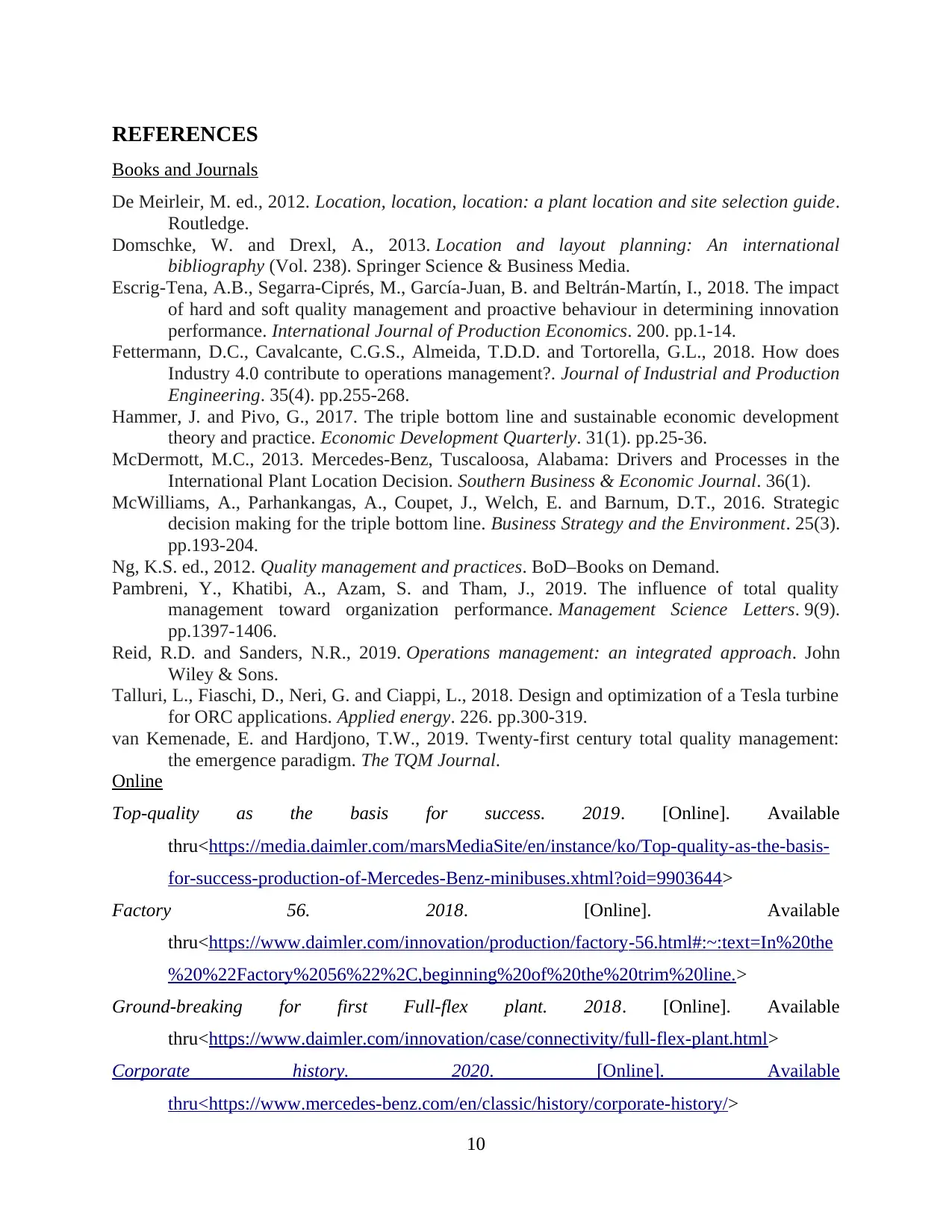
REFERENCES
Books and Journals
De Meirleir, M. ed., 2012. Location, location, location: a plant location and site selection guide.
Routledge.
Domschke, W. and Drexl, A., 2013. Location and layout planning: An international
bibliography (Vol. 238). Springer Science & Business Media.
Escrig-Tena, A.B., Segarra-Ciprés, M., García-Juan, B. and Beltrán-Martín, I., 2018. The impact
of hard and soft quality management and proactive behaviour in determining innovation
performance. International Journal of Production Economics. 200. pp.1-14.
Fettermann, D.C., Cavalcante, C.G.S., Almeida, T.D.D. and Tortorella, G.L., 2018. How does
Industry 4.0 contribute to operations management?. Journal of Industrial and Production
Engineering. 35(4). pp.255-268.
Hammer, J. and Pivo, G., 2017. The triple bottom line and sustainable economic development
theory and practice. Economic Development Quarterly. 31(1). pp.25-36.
McDermott, M.C., 2013. Mercedes-Benz, Tuscaloosa, Alabama: Drivers and Processes in the
International Plant Location Decision. Southern Business & Economic Journal. 36(1).
McWilliams, A., Parhankangas, A., Coupet, J., Welch, E. and Barnum, D.T., 2016. Strategic
decision making for the triple bottom line. Business Strategy and the Environment. 25(3).
pp.193-204.
Ng, K.S. ed., 2012. Quality management and practices. BoD–Books on Demand.
Pambreni, Y., Khatibi, A., Azam, S. and Tham, J., 2019. The influence of total quality
management toward organization performance. Management Science Letters. 9(9).
pp.1397-1406.
Reid, R.D. and Sanders, N.R., 2019. Operations management: an integrated approach. John
Wiley & Sons.
Talluri, L., Fiaschi, D., Neri, G. and Ciappi, L., 2018. Design and optimization of a Tesla turbine
for ORC applications. Applied energy. 226. pp.300-319.
van Kemenade, E. and Hardjono, T.W., 2019. Twenty-first century total quality management:
the emergence paradigm. The TQM Journal.
Online
Top-quality as the basis for success. 2019. [Online]. Available
thru<https://media.daimler.com/marsMediaSite/en/instance/ko/Top-quality-as-the-basis-
for-success-production-of-Mercedes-Benz-minibuses.xhtml?oid=9903644>
Factory 56. 2018. [Online]. Available
thru<https://www.daimler.com/innovation/production/factory-56.html#:~:text=In%20the
%20%22Factory%2056%22%2C,beginning%20of%20the%20trim%20line.>
Ground-breaking for first Full-flex plant. 2018. [Online]. Available
thru<https://www.daimler.com/innovation/case/connectivity/full-flex-plant.html>
Corporate history. 2020. [Online]. Available
thru<https://www.mercedes-benz.com/en/classic/history/corporate-history/>
10
Books and Journals
De Meirleir, M. ed., 2012. Location, location, location: a plant location and site selection guide.
Routledge.
Domschke, W. and Drexl, A., 2013. Location and layout planning: An international
bibliography (Vol. 238). Springer Science & Business Media.
Escrig-Tena, A.B., Segarra-Ciprés, M., García-Juan, B. and Beltrán-Martín, I., 2018. The impact
of hard and soft quality management and proactive behaviour in determining innovation
performance. International Journal of Production Economics. 200. pp.1-14.
Fettermann, D.C., Cavalcante, C.G.S., Almeida, T.D.D. and Tortorella, G.L., 2018. How does
Industry 4.0 contribute to operations management?. Journal of Industrial and Production
Engineering. 35(4). pp.255-268.
Hammer, J. and Pivo, G., 2017. The triple bottom line and sustainable economic development
theory and practice. Economic Development Quarterly. 31(1). pp.25-36.
McDermott, M.C., 2013. Mercedes-Benz, Tuscaloosa, Alabama: Drivers and Processes in the
International Plant Location Decision. Southern Business & Economic Journal. 36(1).
McWilliams, A., Parhankangas, A., Coupet, J., Welch, E. and Barnum, D.T., 2016. Strategic
decision making for the triple bottom line. Business Strategy and the Environment. 25(3).
pp.193-204.
Ng, K.S. ed., 2012. Quality management and practices. BoD–Books on Demand.
Pambreni, Y., Khatibi, A., Azam, S. and Tham, J., 2019. The influence of total quality
management toward organization performance. Management Science Letters. 9(9).
pp.1397-1406.
Reid, R.D. and Sanders, N.R., 2019. Operations management: an integrated approach. John
Wiley & Sons.
Talluri, L., Fiaschi, D., Neri, G. and Ciappi, L., 2018. Design and optimization of a Tesla turbine
for ORC applications. Applied energy. 226. pp.300-319.
van Kemenade, E. and Hardjono, T.W., 2019. Twenty-first century total quality management:
the emergence paradigm. The TQM Journal.
Online
Top-quality as the basis for success. 2019. [Online]. Available
thru<https://media.daimler.com/marsMediaSite/en/instance/ko/Top-quality-as-the-basis-
for-success-production-of-Mercedes-Benz-minibuses.xhtml?oid=9903644>
Factory 56. 2018. [Online]. Available
thru<https://www.daimler.com/innovation/production/factory-56.html#:~:text=In%20the
%20%22Factory%2056%22%2C,beginning%20of%20the%20trim%20line.>
Ground-breaking for first Full-flex plant. 2018. [Online]. Available
thru<https://www.daimler.com/innovation/case/connectivity/full-flex-plant.html>
Corporate history. 2020. [Online]. Available
thru<https://www.mercedes-benz.com/en/classic/history/corporate-history/>
10
Paraphrase This Document
Need a fresh take? Get an instant paraphrase of this document with our AI Paraphraser

11
1 out of 11
Related Documents
Your All-in-One AI-Powered Toolkit for Academic Success.
+13062052269
info@desklib.com
Available 24*7 on WhatsApp / Email
![[object Object]](/_next/static/media/star-bottom.7253800d.svg)
Unlock your academic potential
Copyright © 2020–2025 A2Z Services. All Rights Reserved. Developed and managed by ZUCOL.




